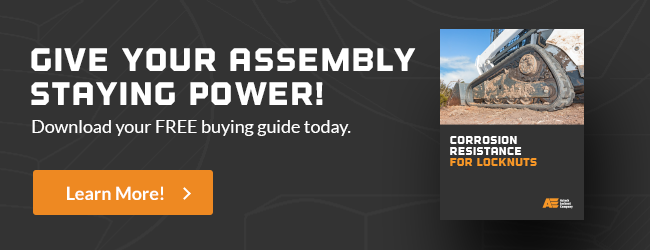
Choosing a locknut coating is difficult not only because of the variety of coatings available, but also because of the terminology used to describe the coatings. One specification you will see when choosing a locknut coating is either organic or inorganic. But what does this specification mean and how should it influence your buying process?
The Nature of the Binder
Coatings are specified as organic or inorganic according to the nature of their binder. Organic coatings then are those that have an organic binder, often epoxy. Inorganic coatings are those that have an inorganic coating such as a silicate.
Organic Coatings
Organic coatings are often paints or powders that require several layers before a thick enough coating is achieved to inhibit corrosion. The coating must be dense and durable.
Inorganic Coatings
Inorganic coatings encompass “surface conversion, anodizing, enameling, metallic coatings and more” (“Inorganic coatings”). These coatings are created through a chemical action that changes the surface layer of metal into a metallic oxide film or compound to reduce corrosion.
A Mixed Solution
To get the best life and the ideal properties from both organic and inorganic coatings, occasionally a manufacturer of coatings will create combinations. For example, an inorganic zinc-rich base-coat and an organic aluminum-rich topcoat may be combined to get both heat resistance and the ability to meet OEM friction standards.
Discover the Best Solution for You
Our buying guide “Corrosion Resistance for Locknuts” explores some of the other terms and standards you should be aware of when choosing a locknut coating. Check it out today for FREE. If you have additional questions about organic and inorganic coatings, contact one of our representatives. We would be glad to talk with you!
Resources:
Delgado, Eddy. "Organic and Inorganic Zinc Rich Coatings." Scribd. Scribd, n.d. Web. 16 Dec. 2016. <https://www.scribd.com/doc/149313020/Organic-and-Inorganic-Zinc-Rich-Coatings>.
"Inorganic Coatings." Inorganic Coatings. Corrosion Doctors, n.d. Web. 16 Dec. 2016. <http://www.corrosion-doctors.org/MetalCoatings/Inorganic.htm>.
"Inorganic coatings." Swerea. Swerea, 2016. Web. 16 Dec. 2016. <http://www.swerea.se/en/areas-of-expertise/corrosion-surfacing-technology/corrosion-protection/inorganic-coatings>.
"Organic coatings." Swerea. Swerea, n.d. Web. 16 Dec. 2016. <http://www.swerea.se/en/areas-of-expertise/corrosion-surfacing-technology/corrosion-protection/organic-coatings>.
"Magni 554 Fastener Coating." Magni-554-Product-Data-Sheet.pdf. Magni Coatings, n.d. Web. 16 Dec. 2016. <http://magnicoatings.com/wp-content/uploads/2016/10/Magni-554-Product-Data-Sheet.pdf>.
Poll, Jerry. "Trends in Fastener Finishing." Products Finishing. Products Finishing, 1 Sept. 1997. Web. 16 Dec. 2016. <http://www.pfonline.com/articles/trends-in-fastener-finishing>.




